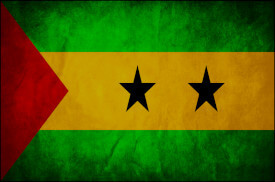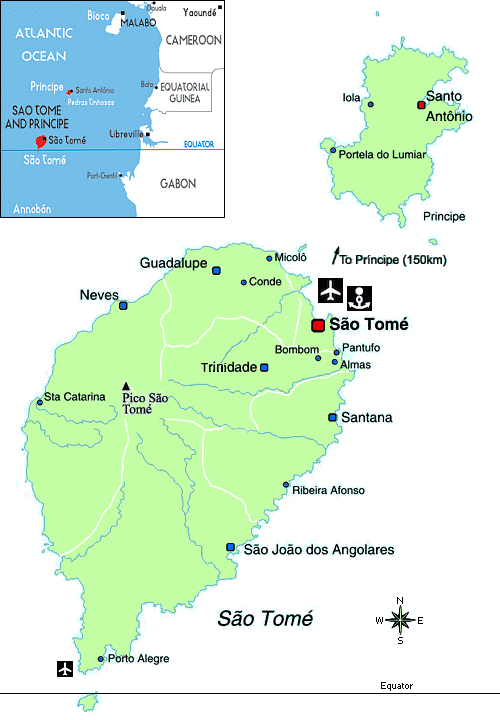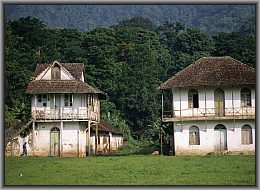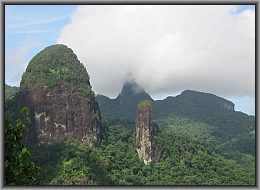
Setup & config options
Suitable power supply
RasPi & sFTP file transfer
Home network print server
Home network scan server
Mesh : home Lan USB drive
Explore hard & software
UFW firewall explained
Secured by fail2ban server
Software packaging & PPA
Apache 2.4+ LAMP server
https web server : port 443
Varnish caching proxy
Module : cgi & perl
Module : geoip
Modules : php & mysql
http*s error handling
Server : conditional logging
TL-domain & dynamic DNS
Webalizer log analyser
Defeat referrer spam
robots.txt & xml sitemaps
Server : .htaccess handling
The game & not the islands
Setup & config options
North Atlantic : Macaronésia
🚫 No ads & tracking
São Tomé & Príncipe overview
The snapshot to the islands São Tomé and Príncipe
This is an older article which I wrote on a free subdomain provided by Wordpress many years ago.
10-Dec 2018

São Tomé and Príncipe, officially the Democratic Republic of São Tomé and Príncipe, is a Portuguese-speaking island nation in the Gulf of Guinea, off the western equatorial coast of Africa. It consists of two islands: São Tomé and Príncipe, located about 150 kilometres apart and about 250 and 225 kilometres, respectively, off the northwestern coast of Gabon. Both islands are part of an extinct volcanic mountain range. São Tomé, the sizable southern island, is situated just north of the equator.
São Tomé is 50 km long and 32 km wide and the more mountainous of the two islands. Its peaks reach 2,024 metres. Príncipe is about 30 km long and 6 km wide. Swift streams radiating down the mountains through lush forest and cropland to the sea cross both islands. The equator lies immediately south of São Tomé Island, passing through an islet named Ilha das Rolas.
An island country in the Gulf of Guinea off western Africa. Probably uninhabited at the time of European discovery in 1471, the islands were settled (1483) by the Portuguese, who held them, except for a period of Dutch rule in the 17-th century, until they gained full independence in 1975. São Tomé is the capital. Population: ca. 170,000.
São Tomé and Príncipe is the second-smallest African country in terms of population (the Seychelles being the smallest). It is the smallest country in the world that is not a former British overseas territory, a former United States trusteeship, or one of the European microstates. It is also the smallest Portuguese-speaking country.
Most of the people are Forro, a mixture of African and European ancestry, or Angolares, the descendants of former Angolan slaves. Languages: Portuguese (official), Creole.
The overview map - São Tomé & Príncipe islands

The facts on history
The islands were visited (1471) by Pedro Escobar and João Gomes, the Portuguese explorers, and in 1483 the São Tomé settlement was founded. They were proclaimed a colony of Portugal in 1522. The Dutch held the islands from 1641 to 1740, when they were recovered by the Portuguese. Until the establishment of a slave-based plantation economy in the 18-th century, the islands were used mainly as supply stations on the shipping routes to Brazil and India.
However, superior sugar colonies in the Western Hemisphere began to hurt the islands. The large slave population also proved difficult to control, with Portugal unable to invest many resources in the effort. Sugar cultivation thus declined over the next 100 years, and by the mid-17-th century, the economy of São Tomé had changed. It was now primarily a transit point for ships engaged in the slave trade between the West and continental Africa.
In the early 19th century, two new cash crops, coffee and cocoa, were introduced. The rich volcanic soils proved well suited to the new cash crop industry, and soon extensive plantations (known as "roças"), owned by Portuguese companies or absentee landlords, occupied almost all of the good farmland. By 1908, São Tomé had become the world's largest producer of cocoa, which remains the country's most important crop.
São Tomé and Principe became an overseas province of Portugal in 1951 and received local autonomy in 1973. Following the 1974 military coup in Portugal, the new government recognized the islands' right to independence, granting it on July 12, 1975. Manuel Pinto da Costa, leader of the Gabon-based Movement for the Liberation of São Tomé and Principe, became the country's first president, and his party the sole legal one. The first years were marked by economic hardship caused by the departure of both the Portuguese and a large number of foreign workers. A severe drought and depressed cocoa prices hurt the economy during the 1980s.
The climate
At sea level, the climate is tropical hot and humid with average yearly temperatures of about 27C and little daily variation. At the interior's higher altitudes, the average yearly temperature is 20C, and nights are generally cool. Annual rainfall varies from 5,000 mm on the southwestern slopes to 1,000 mm in the northern lowlands. The rainy season runs from October to May.
Tropicals and lightweight cottons throughout the year. Umbrellas or light waterproofs for the rainy season are advised.
Weather forecast for São Tomé, São Tomé City
Weather forecast for São Tomé, Neves
Weather forecast for Príncipe, Santo António
🚌 Getting there
TAP Air Portugal operates flights from Lisbon and there is also a scheduled flight from Luanda (Angola) by Air Angola. The airport is 5.5 km from the town. The national carrier Air São Tomé e Príncipe operates daily flights between São Tomé and Libreville (Gabon).
Main port in São Tomé, but this is not deep-water and few international cruise lines or other passenger ships call there. However, boats do sail there from Libreville and Doula.
Transport
There is a bus network and yellow share taxis are also in operation. The only public transport on Príncipe is a minibus.
A limited ferry service operates between São Tomé and Príncipe. Panoramic and charter flights are also available.
Hired cars can be arranged in the capital. There are over 400 km of roads, although in general these are deteriorating. Some of them are asphalted around São Tomé town, but 4-wheel drive vehicles are necessary to get further afield: animals on the road and potholes may cause problems. There is street lighting only in the capital.
Locations of interest
Eco-tourism an increasing trend in Sao Tomé
Although Sao Tomé is still relatively unknown as a tourist destination in many countries, its tourism industry is making an effort to promote the country’s rich natural resources, for example its beaches, the Roças and its unique flora and fauna. These efforts have resulted in growing interest in the country’s eco-tourism, attracting in particular German and Spanish tourists.
African coast: The new target for Sao Tomé tourism
The African coast countries, due to their proximity to Sao Tomé, are seen as the next key targets for the country’s tourism industry. Angola, Nigeria and Gabon are countries of particular interest due to commercial relations and forthcoming oil exploration activities. Although the agreement for the exploration of offshore oil was celebrated between Nigeria and Sao Tomé, it is foreseeable that Angola, due to cultural and language similarities as well as long-term relations with the country, will take the lead in the number of companies exploring Sao Tomé’s oil resources. Tourism agents and companies are developing special packages and are working closely with tourism operators in African coast countries in order to promote Sao Tomé as the “garden” where businessmen and other oil company workers can spend weekends or holidays.
The fact this is not one of the most touristic places in the African continent, maybe merely for promotion purposes, together with the cost attached to getting to the islands - gives a double image to São Tomé e Príncipe: that of a land with a strong traditional image, lost in time; and that of dream beaches. The mixture gives it beauty as both the islands of São Tomé and Príncipe are practically virgin.During the last few years, there has been an attempt to develop the tourism sector. This is understandable. There are a lot of attractions.
But visiting São Tomé e Príncipe doesn't just mean to spend a whole day sunbathing – the island is very close to the Equator line and means that having a warm climate all year long is one of its main attractions – but also invites visitors to adventure and new discoveries.The discovery will lead you to find white sandy beaches, transparent sea, coconut trees, waterfalls and a wildlife which will leave you baffled. The National Obô Park, the São Sebastião Fort or the city market are not to be missed. Believe it or not, people will be welcoming: despite being fairly poor, people from São Tomé always have a smile to offer.


Agostinho Neto : Visit the many roças (cocoa plantations) on the island. Agostinho Neto, the largest plantation in the country, is a clear example of São Tomé's colonial past. Other plantations include Agua Izé, where visitors can tour the plantation by train, Monté Café and Ribeira Peixe.
Beaches : In São Tomé, sandbanks are impressive and also deserted. This is because there is quite a large coastline and you can find beaches in practically all parts of the island. At most, you could see some fishermen leaving to the sea. But believe it that this is the ideal place to try and get your own "private" beach. Right on the Equator, it is easy to understand why going to the beach is one of the best experiences you can have in São Tomé e Príncipe. The temperature of the water is always warm and the colour and transparency charm even the most distracted ones. Very close to the centre of the city of São Tomé you will find a few beaches which, despite not being the best, are very well located with easy access. That is the case of the beach near the São Sebastião Fort or the São Gabriel beach. Heading north, we find the impressive beach of Santana or the Conchas beach, a small bay with little more than 50 metres. Heading south, you can find the Jalé beach, one of the most beautiful and wide beaches in the São Tomé Island where you can see turtles spawn, if you're lucky. In the Príncipe Island, the maritime scenario changes very little: the water is crystalline and warm, with sandbanks between the rocks. The best example is the Bom-Bom beach. Near the city of Santo António, you can also find the sand banks of the Évora da Banana beach, which is only accessible after you managed to cross the dense vegetation.
Boca de Inferno : Visitors can also travel to the Boca de Inferno (Hell's Mouth), a spectacular sight as the blowhole spouts out frothy sprays of seawater several metres into the air and the waterfall near Pousada Boa Vista, the Cascada São Nicolãu. Deep-Sea Fishing Go deep-sea fishing, notably on Bom Bom Island.


Deep sea fishing : Go deep-sea fishing, notably on Bom Bom Island.


Dive and Snorkel : Indulge in swimming, snorkelling and diving in some of the clearest waters on the western coast of Africa. Beaches here have white as well as black sand. Lagoa Azul (Blue Lagoon) on São Tomé is good for snorkelling.
Fort São Sebastião : Fort São Sebastião, built in 1575 and now the São Tomé National Museum is a really beautiful example of a well prepowered 16th century Portuguese colonial fort. The real think is the fort itself to see but the Museum does have some interesting history of Sao Tome. Old photos of the families and explanation of the slavery and way of life in the cocoa and coffee plantations.
umpback Whales : Watch for whales in July to October, when humpback whales come to the waters around São Tomé.
Ilha das Rolas : Ilha das Rolas is a small islet straddling the equator off the southern tip of São Tomé. It's an amazingly beautiful little island, home to the very upscale dive resort, Pestana Equador. If you're up for a splurge you can eat here and enjoy the beach, and they'll provide boat transport to and from their private dock north of Porto Alegre.
Ilha Bom Bom : Dive in a spot that has never seen a diver and the fish can not figure you out. Than the place or one place to go is to Bom Bom resort in the Island of Principe. Beautiful diving, explore the rainforest in a lovely resort. For the diver the water temp is about 28 degrees and the visibility is close to unlimited.
Lagoa Azul : Just beyond the secluded beaches of Praia das Conchas and Praia dos Tamarindos is Lagoa Azul (Blue Lagoon), which has excellent snorkelling but only a rocky beach. The surrounding giant baobab trees are home to numerous bird species.
Obô National Park : The Obô National Park is a protected park in the island of São Tomé which maintains the heritage of traditional plantations. The natural reserve was created in 2006 with the intention to protect the rich biodiversity of the archipelago. It occupies an area of 295 square kilometres which includes two islands (30 percent of the surface of the São Tomé island and more than 50 percent of the Príncipe island), where you can observe rare species, some practically extinct.
The park is located in the interior of the islands and is noted by high forests, with permanent precipitation due to humidity, which makes access difficult. Still, there are many paths taking the visitors to waterfalls and lagoons.One of the activities most appreciated in the island is bird watching.
Pico de Príncipe : Pico de Príncipe is a mountain on Príncipe Island, the smaller of the two inhabited islands of São Tomé and Príncipe. The elevation of the mountain is generally given as 948 m, making it the highest peak on the island, but a trip to the peak in 1999 found that it may be lower than that, making the nearby Pico Mencorne the highest point. The island is one of the volcanic swells that make up the Cameroon line of extinct and active volcanoes. The mountain is the remains of a volcano that has been inactive for 15.7 million years. The volcanoes on this island were at first primarily basalt, but later phonolite intruded in their cores. The basalt has been deeply eroded, leaving spectacular towers of the harder phonolite rising almost vertically from the rainforest. The mountain rises from a heavily-forested plateau with elevation 600 to 700 metres. From there, a series of ridges lead to the summit. At higher elevations the trees are more open and there are more epiphytes - plants that grow on the trees. The summit is a small mound surrounded on three sides by precipices.


Pico de São Tomé : Climb Pico de Sao Tomé, the highest mountain in Sao Tomé with 2,024 metres. It will take two or three day and is a beautiful hike. During the climb one needs to climb several smaller mountains before you get to Mesa where you stay overnight.
This loaf would recommend a guide for this trip. On the way up you pass through three climate zones and get to see real tropical Jungle with amazing trees and plants. This Jungle is considered by the scientists who study this stuff very important in fact one of the two most important in Africa because of the variety of plant life. I was told over 800 local plants of which more than 100 are only in Sao Tome. If you are an Orchid lover or a begonia person this is heaven. They have a 3 m over three metre high begonia. Also Birds wow what a place about 60 types of which 15 or twenty are right here in São Tomé.
Príncipe : Smaller than São Tomé, Príncipe has a dramatic landscape of jutting volcanic mountains covered by virgin forest and ringed by clear-water beaches. The island boasts excellent snorkelling and fishing, and locals can provide boats or bikes, or guide you on pretty much any kind of tour you want; negotiate a price.
The island's capital is Santo António, which is about the size of a large European village. The town's architecture is similar to that of São Tomé town but more run-down. The centre of action is the very upscale Bom Bom Island Resort, to the north of the island, which has brought improved infrastructure and some very well-off tourists.
Santo Antonio : Witness the distinctive colonial architecture and atmosphere prepowered in Santo Antonio, the main town of Príncipe, located 150 km from São Tomé.
São João dos Angolares : See the ancient fishing town of São João dos Angolares and the fortress of São Sebastião, which also houses a museum with a collection of religious and colonial art.
São Tomé : São Tomé, portuguese for "Saint Thomas", is the charming capital of the republic of São Tomé and Principe. The city is located on the north east of São Tomé island, in the Gulf of Guinea. It is the country’s largest town, administrative and commercial centre, and the main port with a good fishing industry. São Tomé was founded by Portugal in 1485 and it achieved its independence in 1975. Since 1534, it has been the seat of a Roman Catholic bishop. Today São Tomé is a very picturesque city, with colonial Portuguese architecture and lovely parks. It has an international airport, and a railroad runs to the interior of São Tomé island.
São Tomé's Rainforest Hike through São Tomé's rainforest, stopping for some fascinating and varied birdwatching on the way.
Trinidade : Trinidade is the second largest city in the small island nation of São Tomé and Principe. It is the capital city of São Tomé, which is a separate island from Principe. Although it is located in the Guinea Bay of Central Africa, it is equally Portuguese as African in culture owing to its historical roots. It is a picturesque tourist destination virtually sitting on the equator. Typical equatorial climate prevails in São Tomé - humidity and heat. Average daytime temperatures rise up to 30C. The southern part of the island receives some rain even during the dry season (from June to September). Trinidade has approximately 15,000 residents. Owing to its proximity to the coastline, fishing is an important commercial activity of the inhabitants. An important produce of São Tomé is cocoa, which accounts for nearly 95 percent of exports.
Eating out
There are several restaurants in the capital Sao Tome, some in house restaurants and bars attached to the hotels and resort complex on Bom Bom Island. Some of them serve Portuguese cuisine, others just the local food. Advance bookings are advisable, as they tend to under cater and so run out of food if there is an onslaught of guests! But there are plenty of casual places popular with the locals. The local cuisine is primarily based on fresh fish and seafood and tropical fruits such pineapples, bananas and avocadoes.
Fish and chicken marinated in a spicy sauce and then char grilled just before eating are the favourite items on the menu. Street food bought from wayside vendors basically is food you eat on the move, bread rolls stuffed with canned salami or sausages from Portugal.




